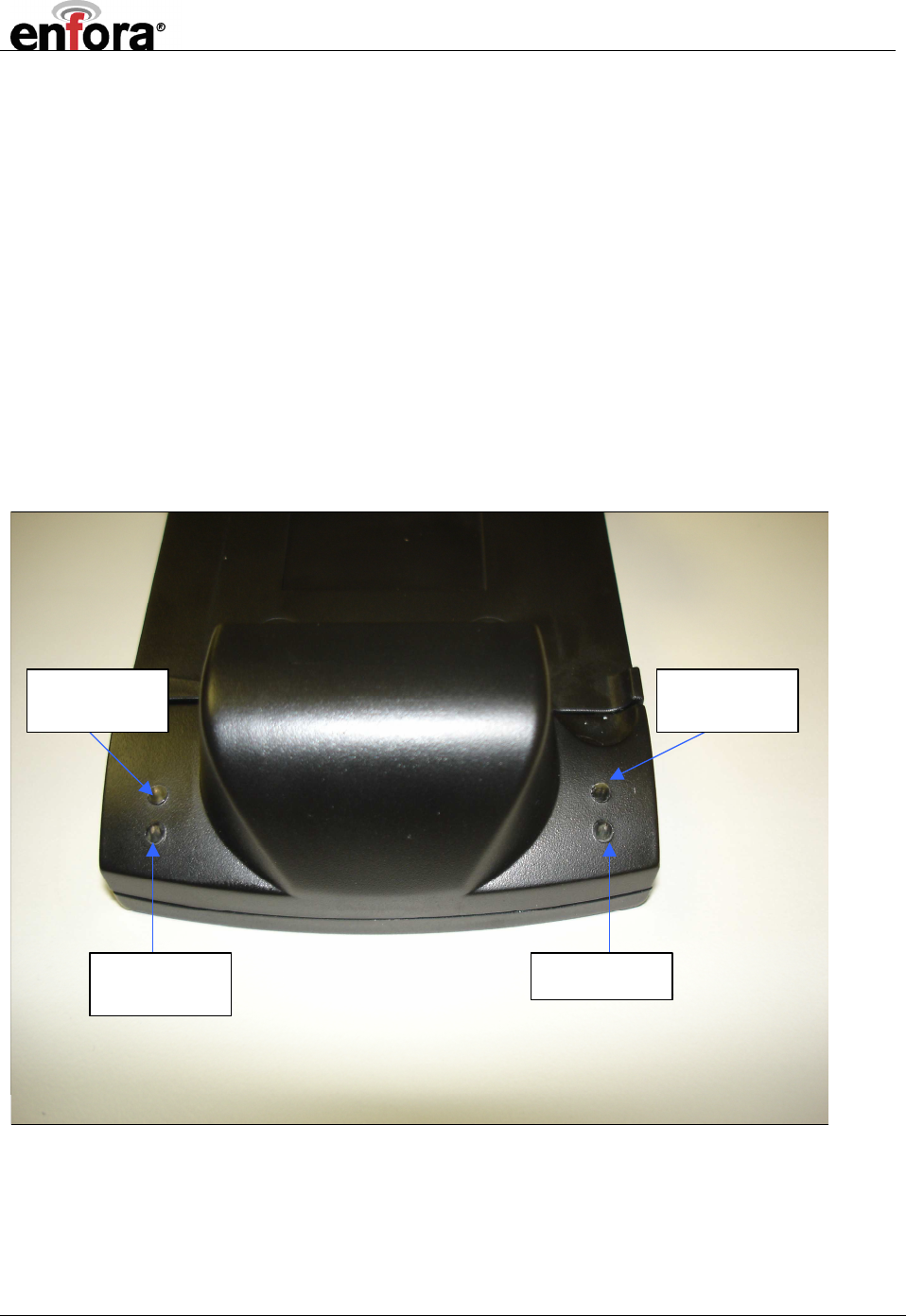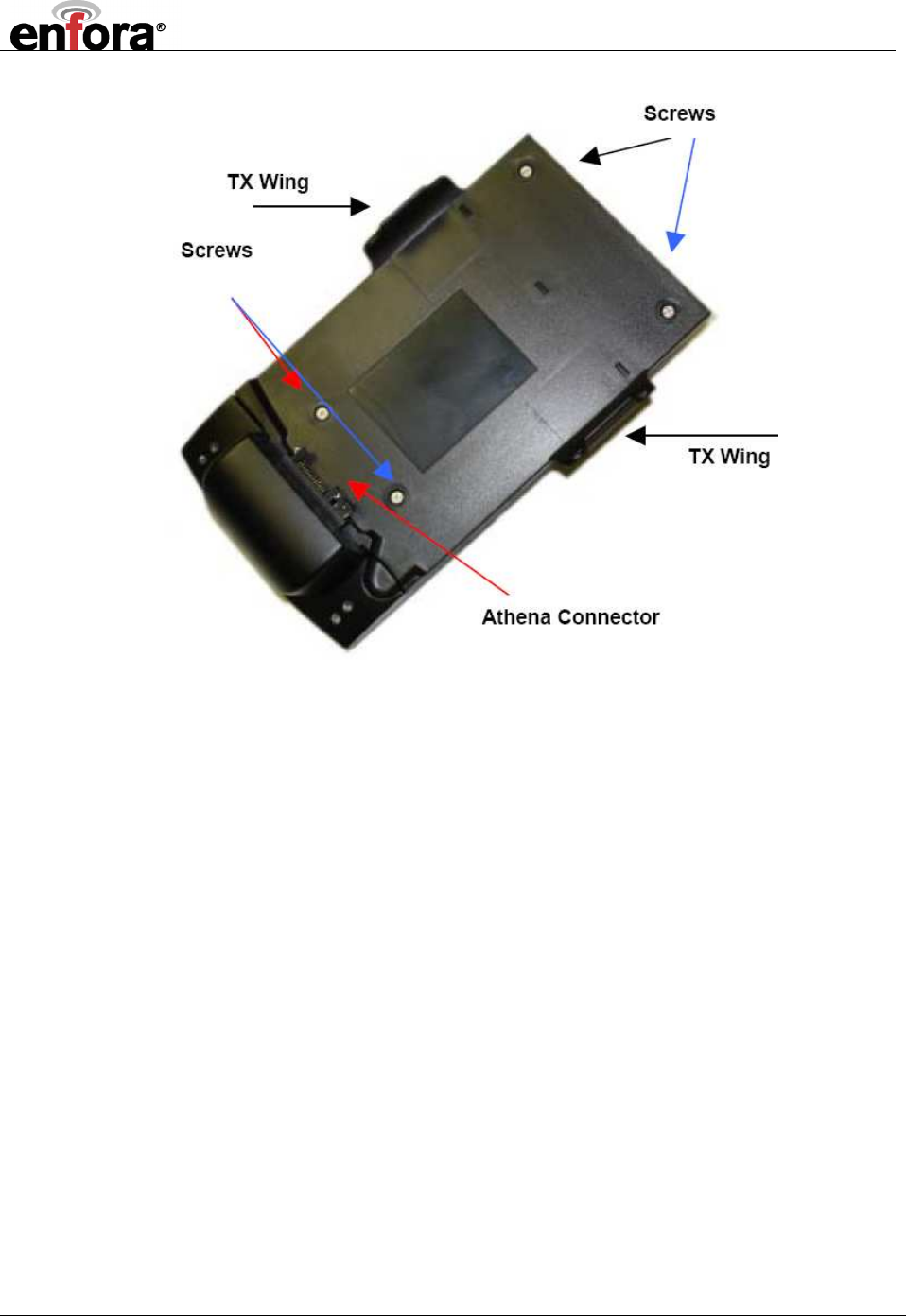Novatel Wireless GSM3408 GSM/GPRS Sled for Palm PDA User Manual Wireless Sled User Guide r1
Novatel Wireless Inc. GSM/GPRS Sled for Palm PDA Wireless Sled User Guide r1
Contents
- 1. User Manual GSM3408
- 2. User Manual GSM0108
User Manual GSM3408

wireless sled user guide r1.doc 1/30/07
Wireless Sled
User Guide
Rev. 1
This document contains confidential and/or copyrightable information of Enfora, Inc. No part of
this document may be copied, disclosed or distributed without the prior written permission of
Enfora, Inc

Wireless Sled User Guide
Page 2 of 14
Information in this document is proprietary to Enfora, Inc.
Table of Contents
1.0
INTRODUCTION......................................................................................................................................3
2.0
GETTING STARTED................................................................................................................................4
3.0
OVERVIEW OF WIRELESS SLED ....................................................................................................5
3.1
P
OWER
.........................................................................................................................................................5
3.2
LED I
NDICATORS
.......................................................................................................................................5
3.2.1
Battery Charge Status LED ...........................................................................................................6
3.2.2
Registration Status LED..................................................................................................................6
3.2.3
Low Battery Status LED..................................................................................................................6
3.2.4
Unused LED.........................................................................................................................................6
3.3
I/O C
ONNECTIONS
.....................................................................................................................................6
3.3.1
PDA Interface (Palm Athena Connector) .................................................................................6
4.0
SIM CARD INSERTION / REMOVAL .............................................................................................7
5.0
BATTERY CHARGING TEMPERATURE..........................................................................................9
6.0
SAFETY INFORMATION FOR WIRELESS DEVICES ............................................................10
6.1
RF E
XPOSURE
...........................................................................................................................................10
6.2
S
CIENTIFIC EVIDENCE ON
RF
EXPOSURE
...............................................................................................11
7.0
FCC COMPLIANCE STATEMENT ....................................................................................................13
8.0
PRODUCT SAFETY INSTRUCTIONS ............................................................................................14

Wireless Sled User Guide
Page 3 of 14
Information in this document is proprietary to Enfora, Inc.
1.0 INTRODUCTION
This document provides a brief introduction to the Enfora® Wireless Sled and basic operating
instructions. Advanced features are described in detail in the following reference documents:
• Enabler-IIG AT Command Set GSM0107PB001MAN

Wireless Sled User Guide
Page 4 of 14
Information in this document is proprietary to Enfora, Inc.
2.0 GETTING STARTED
Getting started with the Enfora Wireless Sled requires the following:
- Wireless Sled (GSM3408)
- Activated SIM card (not supplied)
- Palm E2 or TX PDA (not supplied)

Wireless Sled User Guide
Page 5 of 14
Information in this document is proprietary to Enfora, Inc.
3.0 OVERVIEW OF WIRELESS SLED
3.1 P
OWER
The Wireless Sled contains an internal 3.7 VDC battery for portable use.
Charge the battery for at least 24 hours before initial use using the supplied AC power supply.
Ensure the battery charger has the appropriate AC power adapter for the region you are located
in. Plug the barrel connector into the Wireless Sled and the AC power into the main AC power
source.
3.2 LED I
NDICATORS
The unit has three (3) LED indicators. Refer to Figure 1 for LED locations.
Battery Charge
Status LED
Low Battery
Status LED Undefined
Registration
Status LED
FIGURE 1 – LED Indicator Locations

Wireless Sled User Guide
Page 6 of 14
Information in this document is proprietary to Enfora, Inc.
3.2.1 Battery Charge Status LED
The Battery Charge Status LED is a bi-color LED with Green indicating a fully charged battery
and Yellow indicating the battery is charging.
3.2.2 Registration Status LED
The Registration Status LED is a Green LED that indicates registration status of the device to
the wireless carrier’s network. When the modem is scanning / searching the LED will flash at a
1 second rate and illuminate for 250mS. When the modem is registered the LED will flash at a
5 second rate and illuminate for 250mS. The LED is extinguished when the modem is not
scanning or registered.
3.2.3 Low Battery Status LED
The Low Battery Status LED is a Red LED that indicates when the battery has discharged to
less than 20% capacity. The LED will be extinguished when the battery is above or equal to
20% capacity. The LED flashes at a 2 second rate and illuminates for 250mS when the battery
is less than 20% capacity.
3.2.4 Unused LED
The lower right LED is not defined and is for future use.
3.3 I/O C
ONNECTIONS
3.3.1 PDA Interface (Palm Athena Connector)
An 18-pin connector is provided for serial data communication and power. The table below
provides pin identification and a brief description.
Pin Function
1 +5VDC charge input
2 Adapter ID
3 Ground
4 Ground
5 VBUS
6 USB +
7 USB -
8 Ground
9 Not used
10 Transmit Data
11 Receive Data
12 Not used
13 +3.3VDC out
14 Not used
15 Not used
16 Analog ground
17 Not used
18 Ground

Wireless Sled User Guide
Page 7 of 14
Information in this document is proprietary to Enfora, Inc.
4.0 SIM CARD INSERTION / REMOVAL
The Wireless Sled requires an activated SIM card to operate on the GSM network. The SIM
card is located under the TX wing cover (See Figure 2). Remove the four screws and separate
the TX wing cover from the top cover.
Note:
The SIM card is not provided with the Wireless Sled. The SIM
must be obtained from the GSM/GPRS service provider and
must be provisioned by the operator for data. Always take care
to protect the SIM. Without the SIM installed, the Wireless sled
is not capable of data communications with the network.
Note:
When removing and re-inserting screws ensure the shorter
screws (Quantity 2) located near the Palm PDA mating
connector.
!
Ensure the power to the Wireless Sled is disconnected before
inserting the SIM card. Failure to do so may result in damage to
the Wireless Sled and/or SIM card.

Wireless Sled User Guide
Page 8 of 14
Information in this document is proprietary to Enfora, Inc.
FIGURE 2 – Screw locations
The tray has a sliding latch for retention of the SIM card. The tray must be opened before a SIM
card can be inserted or removed.
Slide the tray to the “unlatched” position and pivot the tray outward.
Insert (or remove) the SIM card, pivot the tray back into the holder and slide the tray to the
“latched” position. Care should be taken to ensure proper orientation of the SIM card in the tray
before closing.

Wireless Sled User Guide
Page 9 of 14
Information in this document is proprietary to Enfora, Inc.
5.0 BATTERY CHARGING TEMPERATURE
The battery may only be charged over a temperature range of 0 °C to 40 °C. Do not charge the
battery cell out of this recommended temperature range.

Wireless Sled User Guide
Page 10 of 14
Information in this document is proprietary to Enfora, Inc.
6.0 SAFETY INFORMATION FOR WIRELESS DEVICES
6.1 RF E
XPOSURE
!
WARNING
Please read this information before using your wireless device.
Your Wireless Sled is a radio transmitter and receiver. It is designed and manufactured not to
exceed the emissions limits for exposure to radio frequency (RF) energy set by the Federal
Communications Commission (FCC) of the U.S. Government. These limits are part of
comprehensive guidelines and establish permitted levels of RF energy for the general
population. These guidelines are based on the safety standards previously set by the U.S. and
international standards bodies. The standards include a substantial safety margin designed to
assure the safety of all persons, regardless of age and health.
The exposure standard for wireless RF devices, such as the Wireless Sled, employs a unit of
measurement known as the Specific Absorption Rate, or SAR. The SAR limit set by the FCC is
1.6W/kg. SAR values at or below that limit are considered safe for the general public.
Before a wireless RF device is made available for sale to the Public, it must be tested and
certified to the FCC that it does not exceed the SAR limits established by the FCC. Tests for
SAR are conducted using the positions and locations (e.g., at the ear or worn on the body) as
required by the FCC for each device model. The Wireless Sled has been tested and meets the
FCC RF exposure guidelines when used as a handheld data communications device. Other
uses may not ensure compliance with FCC RF exposure guidelines.

Wireless Sled User Guide
Page 11 of 14
Information in this document is proprietary to Enfora, Inc.
6.2 S
CIENTIFIC EVIDENCE ON
RF
EXPOSURE
The following information, in large part, is excerpted from, or based on, information provided by
the U.S. Food and Drug Administration (FDA) on its website under the heading “Cell Phone
Facts: Consumer Information on Wireless Phones”
(http://www.fda.gov/cellphones/qa.html). The information provided below reflects
scientific evidence available through the end of 2004. Please visit the aforementioned FDA
website (and the other websites mentioned below) for the latest information.
The available scientific evidence does not show that any health problems are associated with
using wireless phones. There is no proof, however, that wireless phones are absolutely safe.
Wireless phones emit low levels of RF while being used. They also emit very low levels of RF
when in the stand-by mode. Whereas high levels of RF can produce health effects (by heating
tissue), exposure to low-level RF that does not produce heating effects causes no known
adverse health effects. Many studies of low-level RF exposures have not found any biological
effects. Some studies have suggested that some biological effects may occur, but such findings
have not been confirmed by additional research. In some cases, other researchers have had
difficulty in reproducing those studies, or in determining the reasons for inconsistent results.
The FDA and other U.S. government agencies responsible for public health and safety have
worked together and in connection with the World Health Organization (WHO) to monitor
developments and identify research needs related to RF biological effects. It is generally agreed
that further research is needed to determine what effects actually occur and whether they are
dangerous to people. In the meantime, standards-setting organizations and government
agencies are continuing to monitor the latest scientific findings to determine whether changes in
safety limits are needed to protect human health. In 1996, the WHO established the
International EMF Project to review the scientific literature and work towards resolution of health
concerns over the use of RF technology. The WHO maintains a Web site that provides
extensive information on this project and about RF biological effects and research
(
www.who.ch/peh-emf
).
If there is a risk from using wireless phones—and at this point the scientific evidence does not
demonstrate the existence of such a risk—it is probably very small. But if you are concerned
about avoiding even potential risks, you can take a few simple steps to minimize your exposure
to RF. Since time is a key factor in how much exposure a person receives, reducing the amount
of time spent using a wireless phone will reduce RF exposure. If you must conduct extended
conversations by wireless phone every day, you could place more distance between your body
and the source of the RF, since the exposure level drops off dramatically with distance. For
example, you could use a headset and carry the wireless phone away from your body or use a
wireless phone connected to a remote antenna.
Some groups sponsored by other national governments have advised that children be
discouraged from using wireless phones at all. For example, the government in the United
Kingdom distributed leaflets containing such a recommendation in December 2000. They noted
that no evidence exists that using a wireless phone causes brain tumors or other ill effects.
Their recommendation to limit wireless phone use by children was strictly precautionary, and
was not based on scientific evidence that any health hazard exists. More recently, a report
published in January 2005 by the British National Radiological Protection Board (NRPB)

Wireless Sled User Guide
Page 12 of 14
Information in this document is proprietary to Enfora, Inc.
summarized the results of various studies from 2000 to 2004 on the effects of wireless phone
use, and concluded that there is no hard evidence that the health of the public is being harmed
by the use of wireless phones, but that uncertainties remain regarding the risks associated with
long-term wireless phone use. Therefore, the report suggested that a "precautionary or prudent
approach" to reducing RF exposure from wireless phones should be followed until more is
known about these potential risks, including the potential increased sensitivity of children to RF.
The report (NRPB-W65) is available for download at the NRPB website (www.nrpb.org).
Again, the scientific evidence does not show a danger to users of wireless phones, including
children and teenagers. If you want to take steps to lower exposure to RF, the measures
described above would apply to children and teenagers using wireless phones. Specifically,
reducing the time of wireless phone use and increasing the distance between the user and the
RF source will reduce RF exposure.
The FDA scientific staff has reviewed the methodology used by FCC to measure cell phone RF,
and has agreed that it is an acceptable approach, given our current understanding of the risks
presented by cellular phone RF emissions. RF emissions from cellular phones have not been
shown to present a risk of injury to the user when the measured SAR is less than the safety
limits set by FCC (SAR of 1.6 w/kg). The FDA will continue to monitor studies and literature
reports concerning acute effects of cell phone RF, and concerning chronic effects of long-term
exposure to cellular telephone RF (that is, the risks from using a cell phone for many years). If
new information leads FDA to believe that a change to FCC’s measurement policy may be
appropriate, the FDA will contact the FCC, and both agencies will work together to develop a
mutually acceptable approach.

Wireless Sled User Guide
Page 13 of 14
Information in this document is proprietary to Enfora, Inc.
7.0 FCC COMPLIANCE STATEMENT
This device complies with Part 15 of the FCC Rules. Operation is subject to the following two
conditions: (1) This device may not cause harmful interference, and (2) this device must accept
any interference received, including interference that may cause undesired operation.
This equipment has been tested and found to comply with the limits pursuant to Part 15 Subpart
B, Part 22, and Part 24 of the FCC rules. These limits are designed to provide reasonable
protection against harmful interference in an appropriate installation. This equipment generates,
uses, and can radiate radio frequency energy and, if not used in accordance with instructions,
can cause harmful radiation to radio communication. However, there is no guarantee that
interference will not occur in a particular installation. If the equipment does cause harmful
interference in radio and television reception, which can be determined by turning the
equipment on and off, the user is encouraged to try to correct the interference by one or more of
the following measures:
• Increase the separation distance between the equipment and the receiver.
• Contact Enfora Technical Support for assistance.
!
Changes or modifications without the express consent of the
manufacturer may void any applicable warranty and the user’s
authority to operate the equipment.

Wireless Sled User Guide
Page 14 of 14
Information in this document is proprietary to Enfora, Inc.
8.0 PRODUCT SAFETY INSTRUCTIONS
!
Please follow all safety instruction outlined below. Failure to
follow these instructions may result in serious personal injury
and/or property damage.
Always obey all applicable regulations in any area where the Wireless Sled may be used. Turn
your Wireless Sled off in areas where its use is prohibited or where it may cause interference or
danger to anyone.
Use of radio equipment is prohibited in hospitals and may interfere with the use of medical
equipment. Do not use the Wireless Sled in hospitals or near medical equipment. The Health
Industry Manufacturers Association recommends that a minimum separation of six inches (6”)
be maintained between a handheld wireless device and a pacemaker to avoid potential
interference with the pacemaker.
When boarding a plane, follow all instructions of the flight crew on the use of wireless devices.
FCC regulations prohibit using your wireless device during any air flight. Turn off your Wireless
Sled during flight and at all other times as requested by the flight crew by removing the PDA.
Do not use the Wireless Sled in the vicinity of blasting areas where it might interfere with remote
control RF devices used to set off explosives.
Although it is rare, wireless phones can generate sparks. Do not use or store your Wireless Sled
phone around flammable or explosive gas, liquids, chemicals or any other such materials.
Certain jurisdictions prohibit the use of radio communication equipment while driving to avoid
distractions and prevent accidents. Do not use the Wireless Sled while driving.